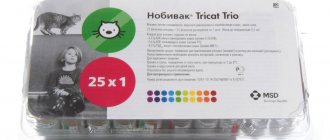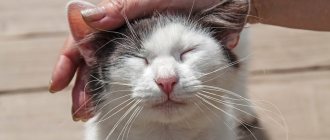Today, as usual, you started petting your pet and discovered that the cat has hot ears. You immediately have a question: why and is this normal? There are various reasons why the temperature of a cat's ears may change. They can be either completely harmless or as a consequence of serious problems with the health of the animal. Let's look at the answer to this question.
A lot of blood vessels are concentrated on a cat’s ears, and since there is the least hair there, the skin can be easily felt. Accordingly, the owner can feel possible temperature changes. In normal condition it is 38 degrees.
Features of cat ears
In animals, there is no muscle tissue or fat layer between the ear cartilage and the skin. Even in dark individuals you can see blood vessels.
A person acutely feels temperature changes of even one degree. In this connection, it can only seem that the pet has hot ears. However, in some cases, worries are justified.
In normal condition, a cat's ears are pale pinkish or white. If they turn red, this indicates increased intravenous pressure or fever.
Treatment
There is no single treatment regimen for ear inflammation in cats. Therapy for diseases is chosen in accordance with the identified pathology.
Otitis, infectious, fungal diseases, otodectosis are treated after consultation with a veterinarian, medications are given to the animal as prescribed and under the supervision of a specialist.
Self-medication is excluded
Only a veterinarian can accurately diagnose and identify pathology .
Self-medication is fraught, the situation may worsen, a secondary infection will develop, the animal will lose hearing or die, experiencing severe pain.
Examination by a veterinarian
At the clinic, the cat will be examined, a history of the disease will be collected, the owner will be interviewed, and swabs will be taken from the ear.
If necessary, the animal will be prescribed a general blood test, ultrasound or x-ray.
Prescribed procedures
To begin with, the auricle is cleaned of contents with veterinary ear lotions. Special products dissolve dirt and exudate.
Depending on the test results, a drug is chosen.
The drug is injected into the ear after it is completely cleansed. The drops are given strictly on schedule, for as many days as prescribed by the veterinarian.
The animal may need antipruritic medications, anti-allergy medications, antiparasitic, antifungal medications, and antibiotics.
How to determine a cat's condition
Owners periodically check the pet's health. If the nose is wet, the ears do not burn, there are no other symptoms of the disease, there is no cause for concern.
The following clinical picture should cause alarm:
- the pet becomes passive and indifferent to everything;
- refuses food;
- nose dry and hot;
- the animal constantly wants to sleep, lethargic;
- there is diarrhea or constipation;
- the fur became dull and began to accumulate in lumps;
- vomit comes out.
If at least one of the symptoms is present, the cat's temperature should be taken. The rectal method is suitable for animals: the tip of the thermometer is lubricated with Vaseline and inserted into the anus 1-2 centimeters.
Normal values in degrees:
- 37-38: in adult males;
- 38-39: in kittens and pregnant individuals;
- 41.5: in hairless breeds (for example, Sphynxes).
If the temperature is higher than normal and there are other signs of illness, the help of a veterinarian is necessary. After examination, the doctor will make a diagnosis: a viral infection, injury or ear mites.
Normal temperature in cats
If a cat has hot not only ears, but also a nose, then there may be serious health problems.
- The cat's body fights a viral infection
- Various intestinal disorders
- Cold
- Ear mites (symptoms and treatment we discussed above)
- There are a lot of infectious diseases that occur hidden and can only be identified by a specialist.
- External and internal inflammatory processes
- The cat may be injured, but if the damage is internal, you will not be able to determine it yourself
How to determine if your pet is sick
The cat has become lethargic, stopped eating, does not go to the toilet (or tries but fails), sneezes, and has a depressed and apathetic state. By measuring the temperature, you can determine whether there are inflammatory processes in the animal’s body.
What to do?
If your pet's behavior has changed dramatically. Visit a veterinarian, or make a house call, if possible. Don't let your pet's condition take its course. Help him and he will be grateful to you.
Why do my ears get hot?
Owners are very worried when their pets get sick. After all, an animal cannot say what is bothering it. They touch his nose: it should be wet. Sometimes the temperature of the ears is also checked.
Norm
Hot ears occur not only when the cat is sick, but also:
- during sleep, when the organ is heated under the sun or from a battery;
- after long and stormy games;
- if the cat is nervous or overexcited;
- when the pet has been in a hot and stuffy place for a long time.
In these cases there is no cause for concern.
Pathology
If, after measuring the temperature, the column shows an excess of the permissible values, changes in the pet’s behavior are observed, it is most likely sick. There is no point in trying to treat it yourself. This can cause harm.
The cat needs to be shown to a veterinarian. Only he is able to determine the pathogenesis of the pathological condition and select the correct treatment regimen.
Signs of illness
If owners notice a hot nose on their cat, they should be concerned as soon as possible and make an appointment with a doctor when one of the following symptoms is added:
- the animal does not drink water for a long time;
- the cat refuses to eat;
- avoids owners, hides, does not want to play;
- shows aggression, runs around the apartment, behaves irritably;
- the animal, on the contrary, becomes apathetic and falls into melancholy;
- there are signs of a cold: sneezing, red eyes;
- Fluid flows from the nose and discharge occurs.
A tick on a cat: bitten, what to do, is it dangerous?
Important! Such signs, along with elevated ear temperature, may indicate a painful condition that requires veterinary intervention.
Viral infection
If the cat's immune system is fighting an infection, its temperature may rise above normal. If your cat has warm ears, there may be other signs of a viral infection: lethargy and decreased appetite.
Viral diseases include acute pathological changes associated with the presence of microorganisms in the blood of an animal. Pathogenic organisms cause various serious consequences that significantly undermine the health of the pet.
Since viral diseases are inflammatory processes, the pet’s body fights by raising the temperature, which manifests itself in the form of hot ears.
Such infections may include: rabies, panleukopenia, rhinotracheitis, calcivirosis, etc.
To alleviate the condition, wrap the animal in a damp soft cloth so that it stops burning.
Viral infections are dangerous for a small kitten. If you have a weak immune system, you cannot do without the use of special medications.
Viral infection causes high fever in cats
Important! Treatment is permissible only on the recommendation of a veterinarian.
Infectious diseases
Ear infections are a common cause of hot cat ears. An ear infection occurs when the cat scratches its ears and tries to rub them on the carpet or corners of furniture. This behavior can lead to inflammation, redness and local fever. Other warning signs of an ear infection may include head shaking, excessive wax, and foul odor from the ears. In this situation, treatment is required as soon as possible to give the cat a chance to get relief before it suffers damage to its eardrums.
Hot ears plus discharge or blood from the ears are serious signs that require a visit to a qualified veterinarian, who will take the earwax for examination to determine the source of the problem and determine the best course of treatment. Various microorganisms can cause ear infections, and only a veterinarian can accurately identify which ones are causing the impact in a particular case.
Note! Among possible infectious diseases, the most common is otitis media.
Signs of this disease:
- the cat is hot to the touch;
- squelching sounds from the ears;
- wet ear discharge;
- the pet does not allow you to touch the sore ear;
- Meows loudly when there is acute pain.
Urgent veterinary care is required in a specialized clinic. The doctor’s recommendations for otitis media must be followed exactly to increase the effectiveness of the procedures.
Important! Infectious diseases in a kitten are more pronounced, since the body is too weak to resist.
Intestinal disorders
An increase in ear temperature may be associated with certain intestinal disorders in the cat. They are characterized by inflammation of the small intestine and are called enteritis. The reasons can be different: viruses, bacteria, protozoa.
Main symptoms of intestinal disorders:
- increased temperature not only of the ears, but also of the whole body;
- loose stools;
- general weakness;
- vomit;
- flatulence;
- dehydration;
- colic;
- refusal to eat;
- heart failure.
Possible intestinal disorders in cats:
- rotavirus enteritis;
- coronavirus peritonitis;
- panleukopenia;
- salmonellosis;
- campylobacteriosis;
- Tizzer's disease.
Intestinal disorders in cats also cause a rise in temperature
Treatment should be prescribed exclusively by a veterinarian.
Injuries, hematomas
Examination of the auricle shows redness and signs of inflammation. Such signs are a consequence of ear hematoma. A hematoma is damage to blood vessels that does not show signs of external bleeding.
If a hematoma is present, the symptoms are:
- the pet is actively scratching its ear;
- rubs his head on the floor and objects;
- there is no discharge from the auricle (for example, as with otitis media).
To eliminate it, it is enough to use a special medicine prescribed by a veterinarian to relieve the hematoma.
Bladder stones
Even bladder stones can be one of the reasons for increased ear temperature. The disease is called cystitis. Accompanied by inflammation of the mucous membrane of the bladder due to infection or the presence of stones.
To make such a diagnosis, a thorough examination is required through laboratory tests of urine, blood, cytoscopy, and ultrasound of the abdominal cavity.
Important! Each specific case requires an individual approach to treatment tactics.
Cold
Colds are common not only to people, but also to pets for the same reasons and factors as in humans. The main symptoms of cat colds are:
- runny nose;
- sneezing;
- chills with an increase in general temperature, including the temperature of the ears and nose;
- lack of appetite;
- apathy;
- arrhythmia;
- cough;
- sleep disorders.
Important! Colds in cats, just like in humans, present with similar symptoms. It is necessary to monitor your pet's immunity, especially in cold seasons. Treatment may be prescribed by your doctor depending on your pet's condition and symptoms.
Ear mite
One of the most common problems cats face involves insect and mite infestations. Fleas and ticks feed on cats' skin, and ears are especially sensitive. In addition, they do not have as much fur as other parts of the body.
The most common mite that appears in cat ears is Otodectes cynotis. It is the size of a grain of salt. The mite becomes active, laying eggs in the cat's ear canal. After three days, new individuals hatch from them, which after 21 days are ready for reproduction. They can be very irritating to your cat, causing her to want to scratch her ear constantly.
Ear mites are parasitic arachnids that burrow inside your cat's ear canals and feed on the tissue and debris in her ears. Scratching causes the ears to become inflamed, which may cause the ear to feel hot to the touch. In addition to intense scratching and hot ears, you may notice excessive amounts of earwax. It resembles coffee crumbs. Prolonged infection and lack of treatment can lead to a secondary ear infection.
Ear mites require veterinary treatment
Note! Ear mites are easily diagnosed by a veterinarian and can be treated.
Mr. Cat recommends: how to bring down the temperature
Hyperthermia can occur in an animal at any time. It is not always possible to immediately go to a veterinary clinic. First aid can be provided at home.
If the mark on the thermometer exceeds normal values, the cat needs to drink a lot. At high temperatures, the pet usually refuses food, but is tormented by thirst. You need to make sure that there is always clean, warm water in the bowl.
Echinacea tincture helps with hyperthermia. It can reduce temperature, activate the immune system, and destroy pathogenic microorganisms. Before giving your cat any medicine, you need to make sure that the dosage is strictly followed. Astragalus can also be used instead of echinacea.
To strengthen the immune system so that the animal recovers faster, it is recommended to give it vitamin C. However, it can only be used after consulting a specialist.
We recommend reading the article about vitamin deficiency in cats, so you can understand whether your pet has vitamin deficiency and what exactly the problem is related to.
Home inspection
To identify any pathology, an examination of the outer and inner surfaces of the pet’s ears is carried out. This is done as soon as one of the symptoms of the disease appears, and the animal’s ears will have the same high temperature throughout the day.
How to conduct an inspection:
- The animal is calmed down, its fur is stroked, and it is placed on your lap. It is important that the pet is in a calm state and does not resist.
The cat is first wrapped in a diaper or blanket so that the animal does not injure its owner.- First, the external part of the auditory concha is examined, scratches, injuries, and hematomas are identified.
- Then the animal’s ear is bent outward and the inside is examined.
- Ear sticks, homemade gauze or cotton swabs do not penetrate the ear. No manipulations should be carried out, this may cause pain to the cat and there is a risk of infection.
- When examining the internal part, pay attention to changes in the color of the skin, rashes, ulcerations, secreted exudate, and injuries.
Before going to the veterinarian, the ears are not treated. At the clinic, swabs will be taken from the animal; all signs of the disease should be fully evident.
Treatment may blur the symptoms, and test results will not be accurate.
Otodectosis - clinical picture
Hot and wet ears of a pet indicate a tick or fungal infection. The nose may remain wet.
When infected with ear mites, an accumulation of brown discharge is observed in the shells. If measures are not taken in a timely manner, the pathological condition will cause the development of otodectosis.
The disease causes the following symptoms:
- itching in the ears;
- restless animal;
- attempts to scratch the ear from the inside (because of this, the cat damages the skin with its claws, which aggravates the condition);
- the pet constantly shakes its head;
- red watery discharge mixed with sulfur and dirt;
- hyperthermia.
With otodectosis, the pet does not allow its ears to be cleaned, becomes very nervous, and screams. Discharge from the sinks is accompanied by squelching sounds. If the listed symptoms occur, you cannot postpone contacting the veterinary clinic. The disease requires long-term and adequate treatment, which can only be selected by a qualified specialist.
Diagnosis of diseases
If a cat's ears are constantly not just warm, but hot, other symptoms of disease often appear. All of them have clear signs and are easy to differentiate.
Otodectosis
Ear mite infestation is not a rare condition in cats. As soon as the animal's ears become hot, they should be examined.
If there is dark, brown discharge inside, the formation of a crust on the mucous membrane, a foul odor, and the cat scratches its ears all the time, this is an infection with ear mites.
Inflammation (otitis media)
The disease affects the outer or inner middle ear.
The main reasons: food allergies, injuries, foreign body ingestion, parasitic, microbial, fungal infections. In addition to hyperthermia, the owner can observe how the animal shakes its head, tilts it towards the inflamed ear, and scratches it.
The cat becomes restless, sometimes aggressive from the pain experienced. With purulent otitis media, fluid is released from the ear canals, and squelching sounds are heard when the animal itches.
Injuries, hematomas
Hematoma is a consequence of mechanical trauma: blow, bite, scratching. It is a clot (collection of blood) under the skin. The liquid coagulates, compacts the vessel, and the compaction displaces the tissue.
The hematoma swells, grows, there is slight inflammation, accompanied by hyperthermia, the ears are dry and red. An injury can be identified by a lump or lump that appears on the outside of the shell.
Infections
This is a large group of diseases of viral, infectious, and fungal origin.
The causes are different, but the symptoms are similar: redness of the inside of the ears, the appearance of discharge, rashes and crusts in the ears, itching.
If there are problems with the ears, the cat will never allow them to be examined and will pull out and scratch. This is the first sign that the animal is experiencing pain.
The pet becomes lethargic, refuses food, his nose is hot and not moist.
What should a healthy cat's nose look like?
A healthy cat's nose is moist, cool and slightly slippery. The cat regularly licks it, and it is covered with a special secretion that creates a protective mucous membrane. For a cat, the nose is not just an organ of smell. With its help, she determines the direction of the wind, the temperature of an object, and even touches it with her nose along with the vibrissae. Constant moisture on the surface of the nose increases its sensitivity, while a dry nose cracks, causes discomfort and cannot cope with its functions.
A very young kitten has a dry nose because it does not yet know how to lick itself, and the moisturizing secretion is not yet released due to age.
Natural causes
All possible causes of this condition are usually divided into natural and pathological. For natural reasons, hot ears in a pet can be felt in the following cases:
- after waking up recently;
- after a long stay near a battery or heater;
- when constantly staying in a stuffy room;
- with excessive excitement.
Therefore, if you discover that your cat has hot ears, you must first analyze the possible natural causes of the problem and rule them out.











